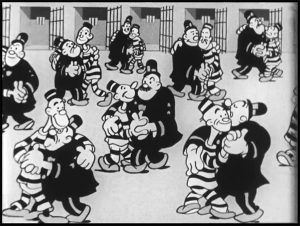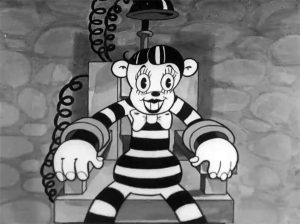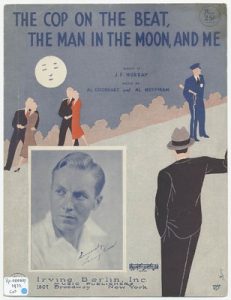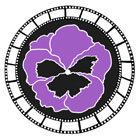The Cartoon Closet is wrapping up this year with two shorts, including a personal favorite of mine, Magic Mummy. But first…

Tight Rope Tricks (1/6/1933, dir. John Foster and George Rufle)
Given how brief the scene is, my Tight Rope Tricks analysis is not going to be as in-depth compared to others I’ve discussed in this series. While I find the sequence interesting, I feel aspects of it can be explored further and in more depth at a later point.
 Set at a circus, Tom and Jerry get ready to perform acrobats for the crowd. Tom pulls the clothesline causing the clothes to fall to the ground, and the two men undress. When they remove their clothes, Jerry is wearing what one typically expects from a male character from this period, a pair of boxers. Meanwhile, Tom unexpectedly has on a bra and frilly panties. This reveal is given no acknowledgement in the short itself. While dressing, there is no music or sound effects playing, and no reaction from Jerry or any other character regarding Tom’s choice of undergarments. The cartoon then cuts to the next scene in the circus ring.
Set at a circus, Tom and Jerry get ready to perform acrobats for the crowd. Tom pulls the clothesline causing the clothes to fall to the ground, and the two men undress. When they remove their clothes, Jerry is wearing what one typically expects from a male character from this period, a pair of boxers. Meanwhile, Tom unexpectedly has on a bra and frilly panties. This reveal is given no acknowledgement in the short itself. While dressing, there is no music or sound effects playing, and no reaction from Jerry or any other character regarding Tom’s choice of undergarments. The cartoon then cuts to the next scene in the circus ring.
To clarify, this sequence is not supposed to be interpreted as a joke about Tom being secretly trans. Instead, it is meant as a way to include a crossdressing gag. Although the blink-and-you’ll-miss-it-frames where Tom has a slightly defined chest does unintentionally allow for a trans reading when examined through a queer theory lens. To me, what stands out on a first viewing is the short makes no attempt to “other” Tom. When it comes to crossdressing jokes, like In the Bag, the humor relies on the audience’s reaction. There’s no need to have a character bring attention to the situation when there’s already an expectation that the viewer takes on the role of the snickering bystander. I initially forgot about how these shorts relied on the viewer. On my first watch, I thought I was misinterpreting the joke. I even theorized that perhaps Tom was wearing some type of unconventional underwear designed for men. This aspect of “laughing at” is what I find especially interesting from a modern perspective concerning gender expression. The joke has shifted into something that, depending on the crowd one socializes with, doesn’t seem all that unusual today. Due to the expectation that the audience would be laughing along, it unintentionally allows for a more accepting interpretation.
As much as I would like to analyze the crossdressing in Van Beuren’s work in further detail, unfortunately, I have not seen the majority of the studio’s output. While I know the studio included similar bra and panty gags, I want to hold off from writing a longer comparison until I’ve viewed more shorts and have a better understanding of how this type of joke was utilized.
Magic Mummy (2/7/1933, dir. John Foster and George Stallings)
Throughout this Tom and Jerry analysis, many of the scenes with coded gay characters or other instances of queerness that I’ve discussed have been quite brief. In terms of identifiably gay coded characters, there’s only been two shorts: Trouble and Pots and Pans released in 1931 and 1932 respectively, an abysmal one short per year. For whatever reason -possibilities could include creatives trying different comedic jokes, increased interest in profiting from the Pansy Craze, and/or less concern about receiving some form of pushback- if someone wanted to see more coded queer representation from this series, 1933 marks a change in the visibility. According to my current research, there was a steady increase in animated queer representation from 1930 until 1933. In 1934, the enforcement of the Code significantly reduced this number. Before the decrease, shorts like Magic Mummy reflected an interest in giving queer characters longer appearances. The short contains the longest amount of visibility on screen from the series yet, clocking in at nearly a minute and thirty seconds and includes one of the most explicitly queer scenes from the series.
The cartoon opens with Tom and Jerry driving their patrol car. When Jerry begins to fiddle with the knobs, the radio frequency shifts and he stops when a cover of The Cop On the Beat, The Man in the Moon, and Me begins to play. The two listen along, providing some musical accompaniment. The film then cuts to an exterior shot of the police department, and proceeds to reveal the two performers, a pair of queer coded policemen. The rest of the scene shifts to the prison, which includes a scene with a group of police and prisoners dancing together. The song ends when the police captain receives a phone call about a recent theft. He rushes to the microphone, where the two policemen are still singing, knocking them off screen in the process. This marks the ending of the song and the queerness found in the short.
For those interested in learning more about The Cop On the Beat, The Man in the Moon, and Me, I referred to the wonderful site Discography of American Historical Recordings (DAHR). Jack Murray wrote the words, along with Al Goodhart and Al Hoffman, who composed the music. It was recorded in New York on October 27, 1932, by the Victor Arden-Phil Ohman Orchestra, with Frank Luther singing vocals. (Click Here to hear it). Further research indicates that the record was released near the end of that year. The song was placed on the B-side, and after the release of Magic Mummy, very few covers of the song were recorded. Compared to the Arden-Ohman Orchestra version, Magic Mummy’s arrangement follows in an upbeat manner, but now sung by a duo rather than a soloist. Nearly all the lyrics are consistent to the original song, but it appears there was either an ad-lib or a last-minute recording direction for the singers. As when the characters are shown later in the scene, neither of their mouths are in sync when they utter “whoops.” There’s something ironic about choosing a song about loneliness that is not only played in an upbeat manner, but the cartoon never depicts anyone who’s actually alone. Tom and Jerry have each other, there are two cops performing the song together, and even the prisoners are coupled with the cops.
Tom and Jerry listening to the radio is significant in this series, as it’s the first time where overtly coded gay men are interacting with the duo. Granted, this interaction is a bit indirect as it’s over radio waves rather than in person, but given how this scene continues, it’s still quite a positive interaction. Before the cops are revealed to the audience, Tom and Jerry are greatly enjoying the song, so much so that as they listen, hearts appear. It’s not entirely clear why they are so enamored with this performance. I do not believe the intention was to imply Tom and Jerry are in love with each other. Although the two have had their queer moments (see my analysis of Jungle Jam or the above Tight Rope Tricks), there’s a subtle touch in the scene that eliminates the possibility the feelings are towards each other. Watching the animation, the hearts only appear when they are facing the radio, never when they are looking directly at one another. However, this does not eliminate if this affection is directed towards the singers. Considering how romantic the song is portrayed in this sequence, it makes determining Tom and Jerry’s reaction tricky. Regardless, I find the ambiguity quite interesting – is it from the song itself, or the singers? – and a detail I particularly enjoy. Watching cartoons from this period, one can risk encountering the mean spirited “laugh at” attitude towards queer characters. Magic Mummy is not entirely immune from depicting queer humiliation, but the fact it depicts the two central characters overtly loving this music unironically is a sweet touch.
 Once the performing cops appear on screen, both scenes -the two singing together and the piano solo- were animated by Frank Tashlin. I first learned about Tashlin’s involvement when researching online reviews. I came across the blogspot Uncle John’s Crazy Town “Van Beuren Produces a Classic (!): Magic Mummy!” from 2010 and noticed a comment written by Milton Knight identifying Tashlin as animating the pianist. I consulted with Devon Baxter, and he confirmed the ID, and noted Tashlin worked on the scene before the piano solo. Between the two scenes, I personally find the piano sequence more enjoyable, showcasing fluid movement and serving as a stronger example of Tashlin’s skills as an animator. During their time on screen, the cops’ coding remains consistent with the period, from their made-up lips, noticeable eyelashes, and limp wrists. They show affection now and then, with moments like resting their faces together and the policeman on the left placing his hand on the other’s cheek. Physically, they differ from the typical type depicted in a Van Beuren short. The studio’s physique preference for gay men was on the thinner side, and with slicked, short dark hair or a coiffed, curly blonde hairdo. The decision to depict them as bald and heavyset is consistent with the visual shorthand associated with their occupation as policemen, rather than reflecting any interest in diversifying or rejecting stereotypes.
Once the performing cops appear on screen, both scenes -the two singing together and the piano solo- were animated by Frank Tashlin. I first learned about Tashlin’s involvement when researching online reviews. I came across the blogspot Uncle John’s Crazy Town “Van Beuren Produces a Classic (!): Magic Mummy!” from 2010 and noticed a comment written by Milton Knight identifying Tashlin as animating the pianist. I consulted with Devon Baxter, and he confirmed the ID, and noted Tashlin worked on the scene before the piano solo. Between the two scenes, I personally find the piano sequence more enjoyable, showcasing fluid movement and serving as a stronger example of Tashlin’s skills as an animator. During their time on screen, the cops’ coding remains consistent with the period, from their made-up lips, noticeable eyelashes, and limp wrists. They show affection now and then, with moments like resting their faces together and the policeman on the left placing his hand on the other’s cheek. Physically, they differ from the typical type depicted in a Van Beuren short. The studio’s physique preference for gay men was on the thinner side, and with slicked, short dark hair or a coiffed, curly blonde hairdo. The decision to depict them as bald and heavyset is consistent with the visual shorthand associated with their occupation as policemen, rather than reflecting any interest in diversifying or rejecting stereotypes.
 This idea of stereotyping based on occupation rather than sexuality carries into the prison dance sequence, which portrays a variety of body types, but no explicit coding for any of the characters. The absence of visual queer coding raises the question if the viewer is supposed to interpret the dancing scene as implying all these men are supposed to be gay. While I can’t confirm that intention, logically, there’s really no other partner options, they are in an all-male prison. With this in mind, it’s the idea of seeing same-sex couples dancing that the viewer is supposed to find funny. Interestingly, none of the characters are depicted as uncomfortable with having a male dance partner. Many of the characters seem to be quite comfortable with their dance partners and are drawn dancing quite close to one another. It’s difficult to be read as a purely platonic scene when views regarding sexuality were changing, as evidenced by Hollywood films from this period. Only a year later, the film Wonder Bar (1934) includes a memorable scene of another man walking up to a dancing couple. Instead of wanting to dance with the woman, he picks the man. Al Jolson notices the exchange, puts on an effeminate mannerism, and declares, “Boys will be boys, woo!”
This idea of stereotyping based on occupation rather than sexuality carries into the prison dance sequence, which portrays a variety of body types, but no explicit coding for any of the characters. The absence of visual queer coding raises the question if the viewer is supposed to interpret the dancing scene as implying all these men are supposed to be gay. While I can’t confirm that intention, logically, there’s really no other partner options, they are in an all-male prison. With this in mind, it’s the idea of seeing same-sex couples dancing that the viewer is supposed to find funny. Interestingly, none of the characters are depicted as uncomfortable with having a male dance partner. Many of the characters seem to be quite comfortable with their dance partners and are drawn dancing quite close to one another. It’s difficult to be read as a purely platonic scene when views regarding sexuality were changing, as evidenced by Hollywood films from this period. Only a year later, the film Wonder Bar (1934) includes a memorable scene of another man walking up to a dancing couple. Instead of wanting to dance with the woman, he picks the man. Al Jolson notices the exchange, puts on an effeminate mannerism, and declares, “Boys will be boys, woo!”
 While queer prison life was not depicted as commonly during the pre-Code era compared to modern media, there was the occasional inclusion. The previous year, Betty Boop for President included a sequence involving prison reform. A tough prisoner is strapped into a machine resembling an electric chair. Instead of killing him, it gives him a makeover, transforming him into an effeminate man. There’s a lot to unpack with this concept, but for simplicity, one of the biggest differences between the prisoner in Betty Boop for President and the prisoners in Magic Mummy is that the latter does not need to convert the prisoners to depict their queerness. There is something refreshing about seeing a queer gag (even if it’s aimed from a “laugh at” rather than “laugh with”) where visual stereotyping is not utilized to depict sexuality and instead the depiction centers on the character’s interaction. Despite how amusing this and the previous scenes are, a major aspect that complicates matters is the cartoon’s inclusion of queer cops and partnering them with the prisoners. There is an incredibly painful history between the queer community and the police. This complexity, though, I doubt was in mind during the development of the short. If anything, I’d theorize this decision more likely reflects an effort to insult authority by portraying the cops as gay. For those interested in learning more about this history I recommend George Chauncey’s Gay New York: Gender, Urban Culture, and the Making of the Gay Male World, 1890–1940 or Anna Lvovsky’s Vice Patrol: Cops, Courts, and the Struggle over Urban Gay Life before Stonewall.
While queer prison life was not depicted as commonly during the pre-Code era compared to modern media, there was the occasional inclusion. The previous year, Betty Boop for President included a sequence involving prison reform. A tough prisoner is strapped into a machine resembling an electric chair. Instead of killing him, it gives him a makeover, transforming him into an effeminate man. There’s a lot to unpack with this concept, but for simplicity, one of the biggest differences between the prisoner in Betty Boop for President and the prisoners in Magic Mummy is that the latter does not need to convert the prisoners to depict their queerness. There is something refreshing about seeing a queer gag (even if it’s aimed from a “laugh at” rather than “laugh with”) where visual stereotyping is not utilized to depict sexuality and instead the depiction centers on the character’s interaction. Despite how amusing this and the previous scenes are, a major aspect that complicates matters is the cartoon’s inclusion of queer cops and partnering them with the prisoners. There is an incredibly painful history between the queer community and the police. This complexity, though, I doubt was in mind during the development of the short. If anything, I’d theorize this decision more likely reflects an effort to insult authority by portraying the cops as gay. For those interested in learning more about this history I recommend George Chauncey’s Gay New York: Gender, Urban Culture, and the Making of the Gay Male World, 1890–1940 or Anna Lvovsky’s Vice Patrol: Cops, Courts, and the Struggle over Urban Gay Life before Stonewall.
Closing out this sequence is the humiliation gag. Though I didn’t examine it in prior columns, this concept was previously utilized in the Tom and Jerry series for identifiably coded gay characters, supplying one final closing-out gag at their expense. In Trouble, the scene cuts away just as the drummer destroys his drum, he’s midway in the air, a startled look on his face. With Pots and Pans, the salt jumps into the pansy’s bowl, resulting in a giant wave of soup to form. It’s a bit ambiguous if the wave will just splash on the pansy, but, regardless, he’ll end up with the most soup on him. Interestingly, both times this gag is used it’s cut short midway through the action. Likely another instance of saving time and money by having the viewer “fill in” the rest of the action. Magic Mummy takes a different approach. Instead of the expected quick cut to a different scene halfway through the action, this one shows the whole joke. The cops are still singing The Cop On the Beat, The Man in the Moon, and Me and the police captain barrels into the room heading toward the microphone. He knocks into both men with such force he causes them and the piano to fly off screen. It’s quite an abrupt way to end the musical number, and an even more unexpected way of removing the cops from the scene. However absurd, this joke expects the audience to laugh at how funny it is that these men are getting knocked off screen. Although violence is common in a Van Beuren short, this marks the third occurrence of a humiliating last laugh directed at identifiably coded gay men, suggesting it is not purely coincidental, but an intentional decision by the writers.





































I’d been waiting for James Parten’s Needle Drop Notes to get to “Magic Mummy”, so your information on the song is kind of a Christmas present. Thanks!
Both get into the clothing previously hanging on the line. Tom is not secretly wearing anything. Sloppy. Otherwise, neat post.
Before getting “into the clothing previously hanging on the line” they both pull off the outer garments they’d been wearing; in Tom’s case that reveals his bra and panties, just as described.
I love the song “The Cop on the Beat, the Man in the Moon, and Me”, and sing along with the cops whenever I watch “Magic Mummy”. I think it’s significant, at least in relation to the cartoon, that the “loneliest three” mentioned in the title are all male. The song is told from the point of view of a single man whose home is a gloom-filled room in the middle of a busy city — at a time when single women, as presented by Tin Pan Alley at least, invariably lived with their parents if they weren’t domestic servants.
Compare the 1892 song “My Sweetheart’s the Man in the Moon”, which is clearly told from a feminine point of view. Even if you ignore the photo of singer Bonnie Thornton (wife of songwriter James Thornton) on the cover of the sheet music, the lyrics make multiple allusions to wedded bliss, with a man who’ll “go early to bed, and never stay out with the boys….” (It’s also notable for mentioning the telephone fully seven years before “Hello Ma Baby”, which is commonly acknowledged as the first song to do so.)
Despite its upbeat foxtrot rhythm, “The Cop on the Beat” is a melancholy song, and not only because of its lyrics. The melody contains several passages of descending semitones, which in opera are used to signify tragedy (whereas ascending semitones, conversely, represent passion). In an era of rigidly defined gender roles, when homosexuality was a criminal offence in most jurisdictions, it must have seemed a “lonely old world” indeed.
Excellent article on Tom and Jerry, I’d never noticed that Tom wore a bra and knickers in the cartoon “Tight Rope Tricks”, it’s rather strange that this gag isn’t given more prominence, besides it’s so short that I wonder if the audience of the time could really notice it. As for “Magic Mummy”, note the resemblance between the dance scene of the many policemen and prisoners and that of the animals in VB’s short film “Oom Pah Pah” (1930).
I hope you’ll also mention the effeminate goose character who appears in some of Van Beuren’s cartoons, making her debut in “A Romeo Robin” (1930) and getting a leading role from “Spring Antics” (1932) onwards.
Come on. Tom and Jerry even slept in the same bed. Everybody must have known the score about them. A liking for mermaids does not necessarily denote heterosexual passion.
The definitive rendition of “My Sweetheart…” was performed by Bullwinkle, who replaced “man” with “moose.”
Bullwinkle also replaced all the masculine pronouns in the song with feminine ones. His “Moose in the Moon” was a cow!
I look forward to when/if you get to taking a look at the Flip the Frog series. I’m 32 shorts (out of 38) into the new Thunderbean set, and there has been only one cartoon so far without a “fairy” gag.